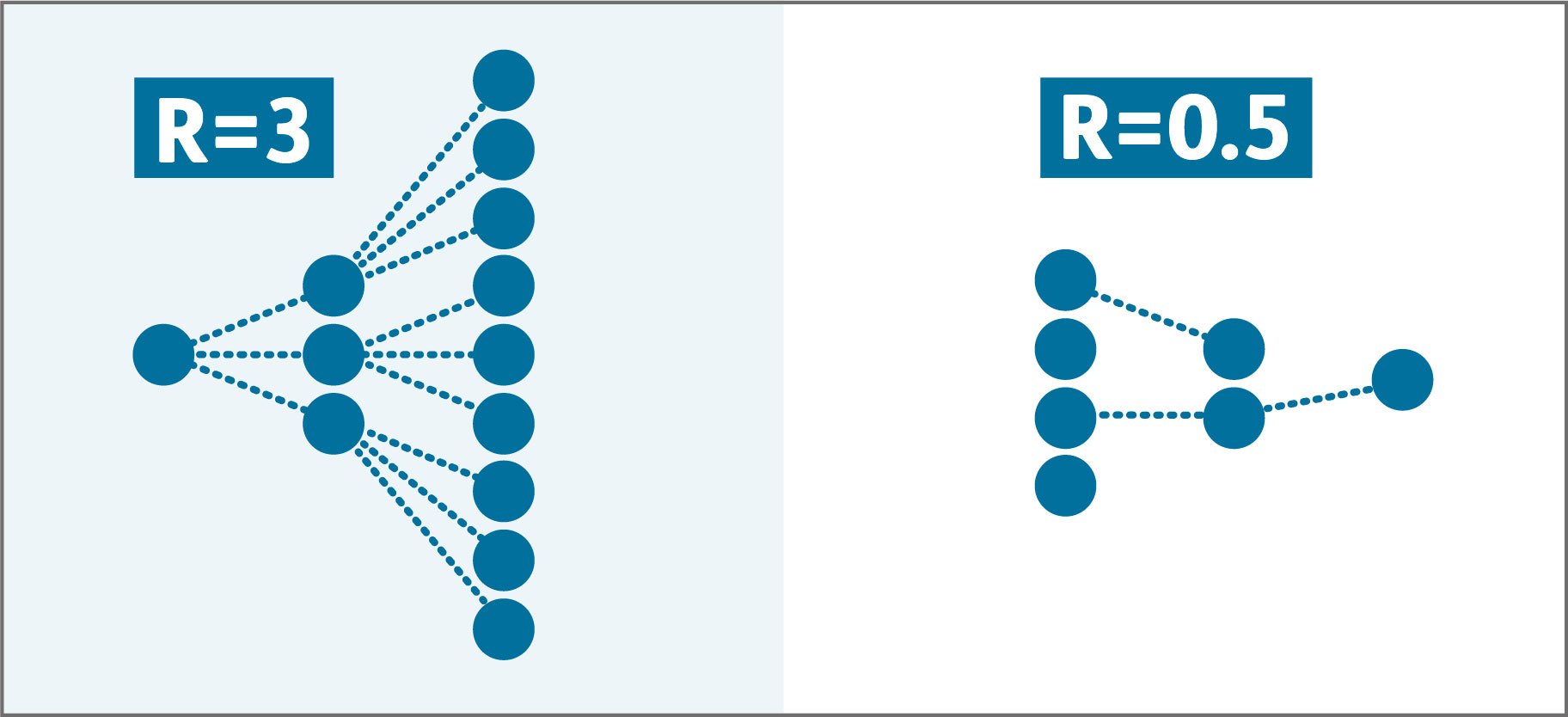We’ve heard a lot about R recently. We’ve heard politicians and scientists discuss whether R is above or below 1, and what that means for the coronavirus outbreak in the UK and the actions the Government is asking us to take. But what is R?
R stands for reproduction number, and it is the average number of people a person who has a disease passes it on to. When R is above 1, the number of people getting the disease increases exponentially and the epidemic continues. When R is below 1, the number of people getting the disease decreases exponentially and the epidemic will eventually end.

When R is 3, as shown in the diagram, 1 person with the disease passes it on to 3 more, who then go on to pass it on to 3 each, resulting in 9 further cases of the disease. These would then go on to cause 27 cases, and then 81 cases. This is exponential growth in the number of people with the disease, with numbers growing very quickly.
When R is 0.5, each person only passes the disease on to an average of half a person. In reality, not everyone will pass on the disease to exactly the number of people that R suggests – clearly we can’t pass on a disease to half a person. In epidemics there are some people who don’t pass the disease on to anyone, and others who are ‘super spreaders’ and pass it on to many more. If R is 0.5, 4 people who have the disease will only pass it on to 2 people between them, and they then only pass it on to 1 person. In this way, keeping R below 1, the epidemic is brought to an end.
Please note: for the purposes of this piece, and discussing the spread of coronavirus in the UK, we are describing it as an epidemic.
What happens at the beginning of an epidemic?
There are actually two reproduction numbers: R0 (R nought), which is the basic reproduction number, and Re, the effective reproduction number. Both reproduction numbers are important at different stages of an epidemic.
At the start of an epidemic, when nobody has had the disease and everyone is susceptible to catching it, R0 is important.
R0 is primarily determined by 3 things:
- How contagious the illness is.
- How long people are contagious for.
- How much contact people tend to have with each other.
It’s difficult to work out an exact value for R0, but estimates for coronavirus suggest it is somewhere between 2 and 4, with an estimate from a team at the University of Oxford of 2.63. At the beginning of the epidemic, the number of people with coronavirus was increasing exponentially in a similar way to that shown in the diagram.
What happens as the epidemic progresses?
As an epidemic progresses, R0 becomes less relevant and Re becomes important. That is because Re is determined by all the same things as R0, but also by the ways we change our behaviour and what proportion of people are still susceptible to the disease.
As diseases spread, people change the way they behave to avoid catching them. With coronavirus we have all used social distancing to limit our contacts with others and reduce our chances of catching and passing on the disease. These changes to our behaviour reduce the number of people a person with coronavirus passes it on to, reducing Re.
Although the science around immunity to coronavirus isn’t clear yet, we think that people who have had it will not be able to catch it again for a period of time. As the coronavirus epidemic has progressed and more people have had it, the proportion of the population who are susceptible to catching it has fallen. This means that some people we have contact with are immune, so if we have coronavirus we will pass it on to fewer people. This also, therefore, reduces Re.
Why have we heard so much about R recently?
While we have all been practicing social distancing, we have reduced Re by minimising the number of people we come into contact with. The evidence the Government is looking at suggests that each person who has coronavirus is currently passing it on to less than one other person, so Re is less than 1 and the epidemic is slowing.
The Prime Minister has said that Re is between 0.5 and 0.9, and that this is one of the reasons the Government has made some changes to their advice on social distancing. There are difficult decisions for the Government and all of us ahead: increases in social contacts will increase Re, and unless we are able to keep it from going above 1 we will see the epidemic start to grow again.

More articles by Dr Webb
Dr Elizabeth Webb is a Senior Research Manager at Age UK. She has an MSc in Epidemiology from the London School of Hygiene and Tropical Medicine and a PhD in Social Epidemiology from University College London.
- What's the science behind the Government's guidelines?
- Can we predict how coronavirus will progress?
- Why are older people more at risk from coronavirus?
- How can we recognise when we have coronavirus?
- How close are we to a vaccine?
- How do we keep R below 1?
- What's the updated picture of coronavirus and older people?
- Is there an increased risk of coronavirus for BAME older people?
- What is k and who are the super-spreaders?


